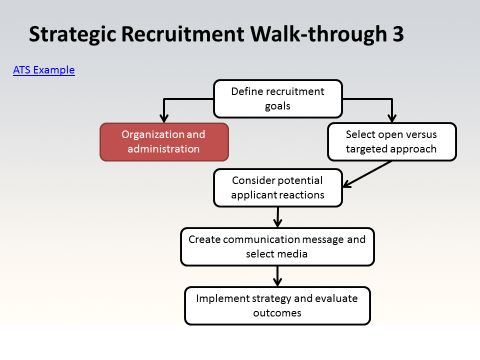Lesson 5 Part 1
Table of Contents
Text and Images from Slide
Strategic Recruitment Walk-through 3
Define recruitment goals
Organization and administration
Select open versus targeted approach
Consider potential applicant reactions
Create communication message and select media
Implement strategy and evaluate outcomes





ATS Example
Lecture Notes
So hopefully you're finding some benefit to this walk through of the strategic recruiting model in the book. And we'll continue here with organization and administration decisions. So when it comes organization and administration there several decisions would want to think through. One would be: do we stay in a house with recruiting or go external? And in the case of InVision, we can see based on their website, that they've clearly seen value and staying in house for their recruiting. Their recruitment appears to be occurring just as such through their website. The size of the organization and the resources will really dictate what happens in many cases with whether they stay in house for recruiting or look externally. So again, InVision clearly has a lot of venture capital funding. It is appearing to grow at a fast rate, and they have the resources to at this point do the recruiting in house. We also might want to think through: Do we have a centralized or decentralized recruiting function? In other words, Does the organization that one centralize point carry out or recruiting for all jobs or do different jobs get recruited by different departments? So this case, we'd probably think about how specific are the jobs we're hiring for. The enterprise account executive is at the end of the day a sales job. So it's likely this is a job where there's not such technical expertise that is centralized function couldn't handle it. So I would think here, probably a centralized recruiting function which allows for economies of scale, things like that, would be most appropriate. Next we'd want to think through lead times. So what is the time horizon between when we post a job and when we would need to be filled? Something that should inform our lead time analysis is what we've discussed recently in this class, planning. So depending on the growth that is foreseen to occur, or perhaps, shrinkage for a certain job, we might want to think through our lead times. And so if it takes us four months to go from expressed candidate interest to actually hiring the candidate, then we'd say we've got a four month lead time, and so based on our planning your whatever number of employees we need eight months from now we should probably start hiring four months from now. Finally we want to think through: How do we handle the process flow and how we keep records of everything that's going on with our applicants? So there's various ways we could go about this. There's certainly in house software and enterprise resource systems that can track all of this for an organization. A company like InVision, with strong IT and web development, is likely using their own system to track what's happening with their applicants. But there might also be ways that we can go out and buy an applicant tracking system instead of make it ourselves. So again in this case, it looks like InVision probably has made their own applicant tracking system, but in other cases a company might want to go out and buy it. So I've provided the link here where you can check out an applicant tracking system example. You might want to click around the linked website which will take you to iCIMS recruiting software page. And iCIMS is just one example of an applicant tracking system that's kind of secure in cloud based online where recruits, all their information is kind of carried out through this software. And you can track all the different metrics that you might be interested in that we will talk about later.
